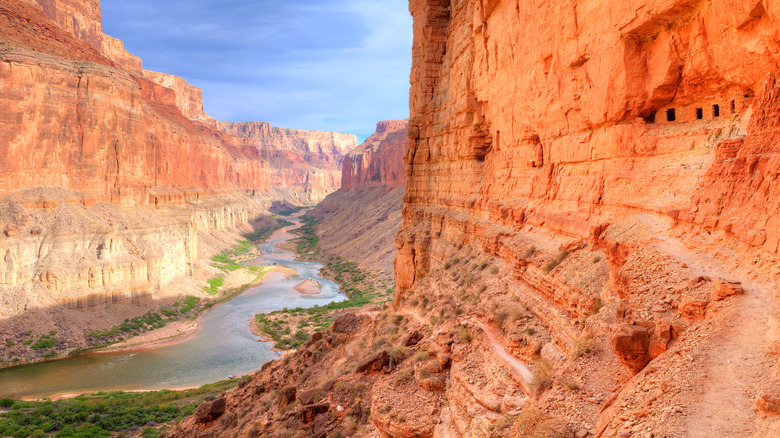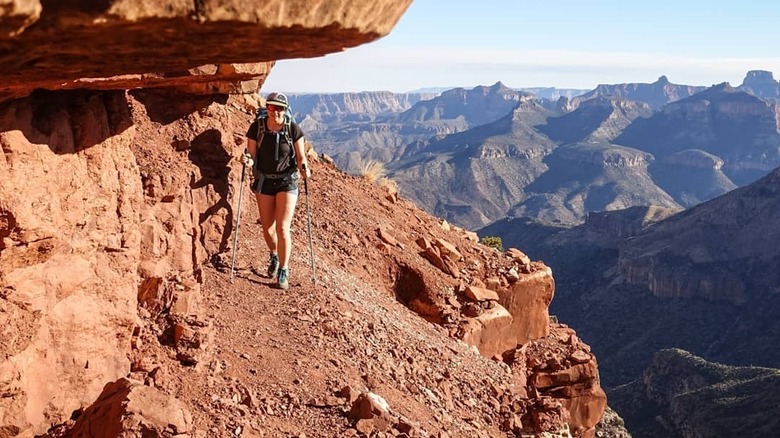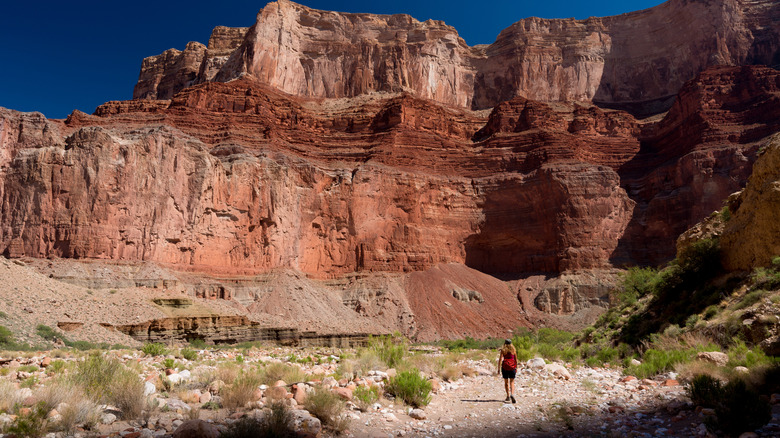The Grand Canyon's Most Dangerous Trail You Should Think Twice Before Attempting
Many Grand Canyon hikes are not for amateurs. But on the bell curve of demanding, one stands out — the Nankoweap Trail. Of all the named trails in the Grand Canyon, this 11-mile hair-raising trek is classified as the most difficult. It's one of the longest trails in the park, lacks signage, and is unmaintained, making it really hard to follow. It also involves the biggest elevation change (5,640 feet) from the rim to the river, meaning a joint-pounding beating on the descent and a brutal uphill marathon on the way back up. But that's just the beginning of the story.
Nankoweap's in a league of its own due to its combined roughness, steepness, and narrowness, not to mention its exposure, which forces hikers to confront their fear of heights, even if they never thought they had one. Imagine, you're hiking on a path barely wider than a footstep on the edge of a screamingly tall cliff, and you're wearing a heavy backpack that's throwing you off balance. Your feet keep sliding on the crumbling rock. The abyss yawns. Get the picture? Besides this, you won't find any water on this trail and there's very little shade, adding the risks of dehydration and heat exhaustion. All these challenges increase exponentially if you happen to get lost.
How to prepare for the Nankoweap Trail
You definitely shouldn't attempt this trail unless you're highly fit and familiar with both desert hiking and navigation. For experienced and ambitious hikers, though, the Nankoweap Trail can be the adventure of a lifetime. Just be sure to follow a few recommendations from park rangers and hikers who've gone before. First, avoid this trail in the hottest part of summer, when its difficulty is compounded by oven-like heat. But even in cooler months, reduce the risk of sunburn and heat exhaustion by hiking in the early morning or late afternoon, when there's more shade. To see how the shade morphs in the canyon throughout any given day, use this ingenious online tool that can be life-saving on a trail like Nankoweap.
Most deaths hereare not from careening off a ledge into the churning Colorado River. They're from heatstroke and dehydration, so be sure to drink enough water. Bring 4 to 6 liters of water per person per day on the trail. To minimize the water you have to carry down into the canyon and then up again, store water bottles along the trail's upper portions for convenient retrieval on the hike out. Another strategy for staying hydrated when hiking in arid desert environments is to add electrolyte powder to your water — an added bonus if it tastes good because then, hopefully, you'll be motivated to drink more often.
Recommended clothing and other gear
Among the usual clothing items in your pack and on your person, here are a few you won't want to be without on Nankoweap. First and foremost, you'll want sturdy boots with good traction to help you avoid slipping on loose shale. It might be tempting to wear shorts while hiking, especially if it's hot, but long pants will protect you from brush along overgrown sections.
Of course, always bring excellent rain gear and ample thermal layers — the weather changes quickly and dramatically inside the canyon. This is one of those places where in the course of a single day, you can literally experience all four seasons: from baking heat inside the canyon to blizzards on the rim. In terms of other essential gear, former Nankoweap hikers recommend bringing a headlamp with extra batteries in case you end up hiking at night. Last but not least, trip reports stress over and over that trekking poles are a must on this trail to help with balance on tricky rough sections!
The Nankoweap Trail (Forest Service Trail #57) is accessible via the Saddle Mountain trailhead near the North Rim of Grand Canyon National Park. A good place to stock up before heading out on the trail is the small but appealing town of Fredonia, known as Arizona's "gateway to the North Rim."


